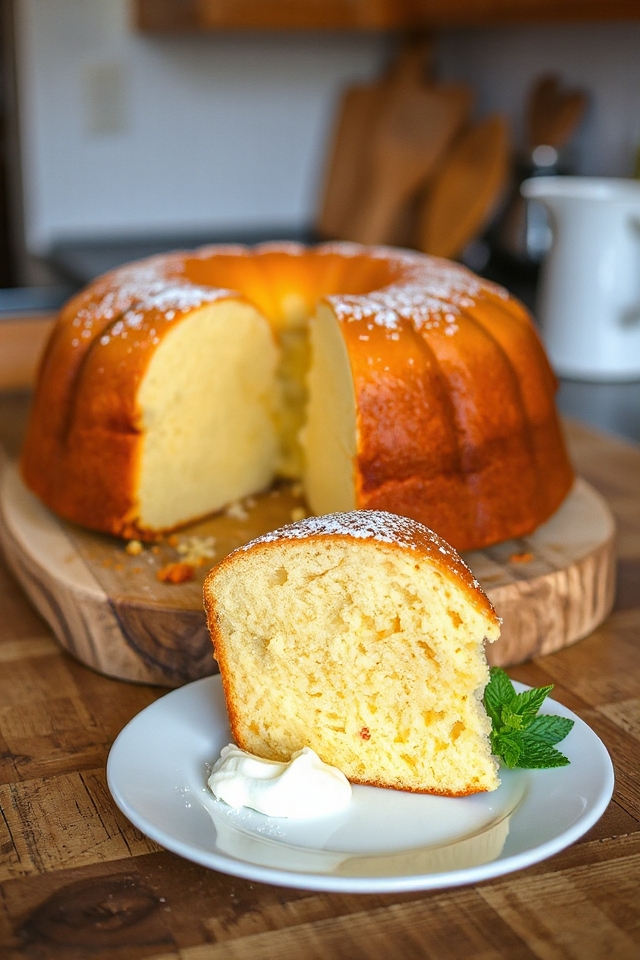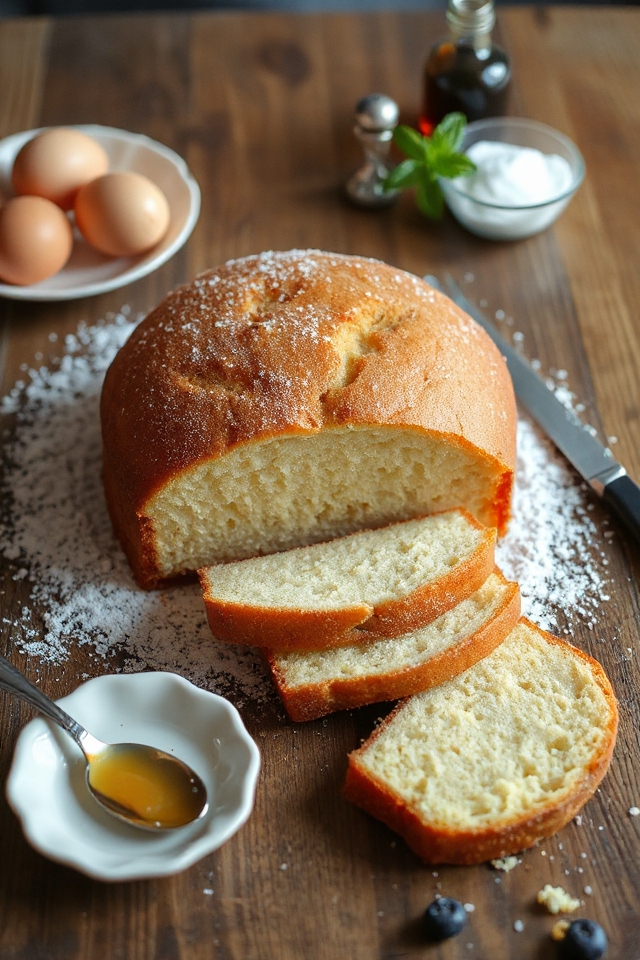Why You’ll Love This Classic Pound Cake Recipe
When you take a bite of this classic pound cake, you’ll immediately understand why it’s a beloved staple in many homes. Its tender, buttery texture melts in your mouth, and the subtle sweetness leaves you craving more.
I love how it pairs perfectly with coffee or tea, making it a great treat for any time of day. Plus, it’s incredibly versatile; you can enjoy it plain, dusted with powdered sugar, or dressed up with fresh berries and whipped cream.
This recipe’s simplicity and rich flavor make it a must-try, and I’m sure it’ll become a favorite in your home too!
Ingredients of Classic Pound Cake
When it comes to baking a classic pound cake, the ingredients you choose can make all the difference. This recipe calls for basic pantry staples that create a rich and buttery flavor, making it a favorite for so many. Plus, the simplicity of the ingredients means you probably have most of them already at home.
So, are you ready to gather what you need and make something delicious? Let’s plunge into the ingredient list!
Ingredients for Classic Pound Cake:
- 1 2/3 cups cake flour (all-purpose flour can work, but cake flour is better)
- 1/2 teaspoon salt
- 1 cup unsalted butter, softened to 65°F (about 2 hours on the counter)
- 1 1/2 cups granulated sugar (superfine is preferred, but regular works too)
- 5 large eggs, at room temperature
- 1 1/2 teaspoons pure vanilla extract
- 1 teaspoon grated lemon zest (optional, but adds a lovely touch)
Now, let’s chat about these ingredients a bit. First off, using cake flour really gives the pound cake that tender crumb we all adore. If you only have all-purpose flour, don’t sweat it, just know it won’t be quite as light.
And remember to let your butter and eggs come to room temperature; this little trick helps everything blend beautifully together.
Oh, and the lemon zest? It’s like a secret handshake between flavors—it brightens up the cake without being too overpowering.
How to Make Classic Pound Cake

Alright, let’s explore the delightful process of making a classic pound cake. First things first, you’ll want to preheat your oven to 325°F and grease a standard 9x5x3 metal loaf pan. I like to use Crisco or softened butter for greasing, and don’t forget to dust it with a bit of flour. Trust me, you don’t want your beautiful cake to stick to the pan like it just won a game of hide-and-seek.
While that’s happening, grab 1 2/3 cups of cake flour and 1/2 teaspoon of salt, and sift them together into a medium bowl. This step is essential because it aerates the flour, leading to that tender crumb we all adore. Now set that bowl aside for a moment while we focus on the creamy goodness that’s about to happen.
Now to the fun part—let’s mix! In your mixing bowl, add 1 cup of unsalted butter that’s nice and soft (aim for around 65°F, which usually takes about 2 hours out of the fridge). Beat it until it’s smooth and creamy, which should take about 30 seconds with a stand mixer or a minute if you’re going old-school by hand.
Next, gradually sprinkle in 1 1/2 cups of granulated sugar—superfine sugar is ideal, but regular works too—while continuing to beat until the mixture is light and fluffy. We’re talking about a transformation here, folks; it should be almost white and airy after about 3 minutes.
Now, here’s where the magic happens: add 5 large eggs, one at a time, beating for 20 seconds after each addition. If you’re like me and have a knack for spilling, just take your time—no rush. The mixture should look dull and smooth, and if it’s acting grainy, it might be too cold. Just let it warm up a bit before you beat it again.
Once you’ve got that lovely egg mixture, add in 1 1/2 teaspoons of pure vanilla extract. Go ahead, take a moment to inhale that vanilla bliss. Then, sift the flour mixture into the batter in three parts, folding it in gently after each addition. Be careful not to overmix here; we want to keep that tender crumb intact.
After everything’s combined, pour the batter into your prepared pan and pop it in the oven. Bake for about 70 minutes, and don’t forget to rotate the pan halfway through—this helps it bake evenly. Use a wooden toothpick to check for doneness; if it comes out clean, you’re golden.
Let it cool for about 5 minutes in the pan before transferring it to a rack. And there you have it, a classic pound cake that’s sure to make you feel like a baking superstar, even if you still have flour on your nose. Enjoy!
Classic Pound Cake Substitutions & Variations
Though the classic pound cake recipe is a timeless delight, there’s always room for creativity with substitutions and variations.
I love swapping out the vanilla extract for almond or adding a splash of citrus, like orange or lemon juice, to brighten the flavor.
For a richer texture, you can replace some butter with cream cheese. If you’re aiming for a lighter cake, try using Greek yogurt instead of some butter.
You can even experiment with different flours, like almond or coconut, for a gluten-free option. Don’t forget to throw in nuts or chocolate chips for an extra treat!
What to Serve with Classic Pound Cake
Classic pound cake offers a wonderful canvas for pairing with various accompaniments.
I love serving it with fresh berries, like strawberries or blueberries, which add a burst of flavor and color. A dollop of whipped cream brings a creamy texture that complements the cake’s density beautifully.
For a twist, I often drizzle a simple lemon glaze over the top, enhancing its sweetness. Ice cream, especially vanilla or lemon, pairs perfectly, turning dessert into a delightful treat.
Finally, a cup of tea or coffee alongside the cake elevates the experience, making it a perfect choice for any gathering or cozy afternoon.
Additional Tips & Notes
When baking a pound cake, it’s essential to pay attention to the temperature of your ingredients. Make sure your butter and eggs are at room temperature; this helps them blend smoothly, ensuring a light texture.
If you’re using a dark pan, consider lowering the oven temperature by 25 degrees to prevent over-browning. I also recommend letting the cake cool completely before slicing to maintain its structure.
For added flavor, experiment with citrus zests or a dash of almond extract. Finally, remember that every oven is different, so keep an eye on your cake as it bakes for perfect results!
